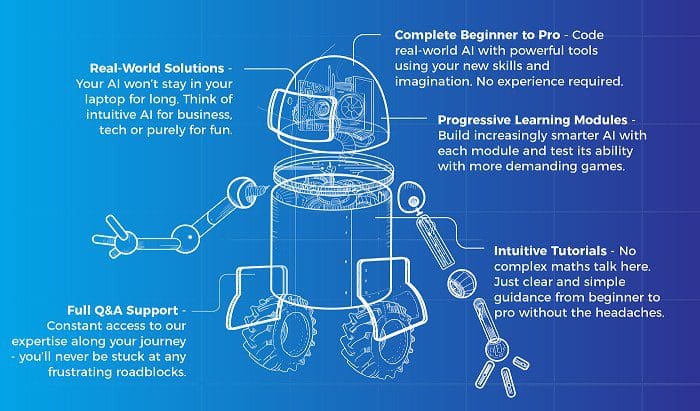The Path To Learning Artificial Intelligence
Learn how to easily build real-world AI for booming tech, business, pioneering careers and game-level fun.
By Kirill Eremenko and Hadelin de Ponteves , Super Data Science.
The path of learning about Artificial Intelligence is often overwhelming with complex math and technical topics. But it doesn’t have to be like that… We want to break that trend by creating an intuitive and exciting course which will guide you into the exploding World of AI and where you will have fun at the same time:
Join The Artificial Intelligence Online Course Here [Link: http://bit.ly/2BuildAI ]
Right this very moment we are running a Kickstarter Project to create a revolutionary training program on Artificial Intelligence. In this blog we are going to describe the secrets behind the structure of the course so even if you aren’t ready to join this training – you can replicate these steps in your own learning program.

Fig. Artificial Intelligence, Machine Learning and Deep Learning
In this AI journey we will implement four levels of Artificial Intelligence, from simple to advanced:
- AI Level 1: Q-Learning
One of the simplest AI algorithms is called Q-Learning. Simple but powerful, we will use it to train a robot like R2D2 to findits way out of a maze. This will be the first AI we will make in the course, just to warm up while having fun.
- AI Level 2 – Deep Q-Learning
Then we will bump things up to the next level by studying Deep Q-Learning (DQN). With DQN we will be able to solve a more challenging problem: conquering the popular game of Breakout! For this challenge our inputs will be vectors of encoded values, all describing one state of the environment, that is: the coordinates of the position of the ball, the coordinates of the vector of direction where the ball is going, and maybe some binary values for each of the bricks being 1 if the brick is still there and 0 if not.

Fig. An AI Playing Breakout
The idea of Deep Q-Learning is to combine the Q-Learning algorithm with a Neural Network. Our inputs are our encoded vectors. They go into a neural network for which the output will be the action to play.
This is already a more advanced AI but we can go further: what if the inputs were not some encoded vectors, but literally the images we see on the screen when playing the game? That brings us to AI Level
- AI Level 3 – Deep Convolutional Q-Learning
Here we go! With this one we will be building an AI which will be very close to a human playing the game. Since an encoded vector doesn’t preserve the spatial structure of an image, this is not the best form to describe a state. The spatial structure is indeed important because it gives us more information to predict the next state, and predicting the next state is, of course, essential for our AI to know what the right next move is. Therefore, we need to preserve the spatial structure and to do that, our inputs must be 3D images (2D for the array of pixels plus one additional dimension for the colors). In this case, the inputs are simply the images of the screen itself, identical to what a human sees when playing the game. Following this analogy, the AI acts like a human: it observes the input images of the screen when playing the game, the input images go into a convolutional neural network (the brain for a human) which will detect the state in each image, and then by predicting the next state thanks to Q-Learning, the AI/Human will predict the best action to play. And again, this action is the output of the neural network.
We will build this highly advanced AI to take on the challenge of passing a level in the very popular game Doom.
- AI Level 4 – Asynchronous Actor-Critic Agents (A3C)
What if there are several agents to train in the environment? In that case, the best AI to build is called A3C, the hottest topic in Artificial Intelligence, introduced by Google DeepMind last year. We would like to implement this AI for several driving cars running on a same map. We will train the cars to avoid themselves and to avoid obstacles. A pretty exciting challenge to end this AI journey!

Join Us
This is the approach we will be taking in our brand-new course on Artificial Intelligence. You are welcome to copy it if you’d like to structure your own learning program… But how much more exciting would it be to learn in a group with others?
Our Kickstarter to create this course has already been backed by over 1,500 students. We have only a few days to go – come join us inside and get the course as well as tons of Early Bird Bonuses!
Learn How To Build An AI [Link: http://bit.ly/2BuildAI ]
Artificial Intelligence is a skill which should be accessible to everyone, and this is not only a chance to learn AI, but to be at the forefront of the next industrial revolution.
Kind regards,
Hadelin de Ponteves & Kirill Eremenko
Notes: Copyright over images #1 and #3 belongs to SuperDataScience Pty Ltd. Use by KDNuggets in this blog and any related promotional media is approved.
Bio: Kirill Eremenko is a multilingual entrepreneur with 3 years of experience in the space of education and 7 years of experience in Data Science. And Hadelin de Ponteves is Data Engineer at Google.
Related:
